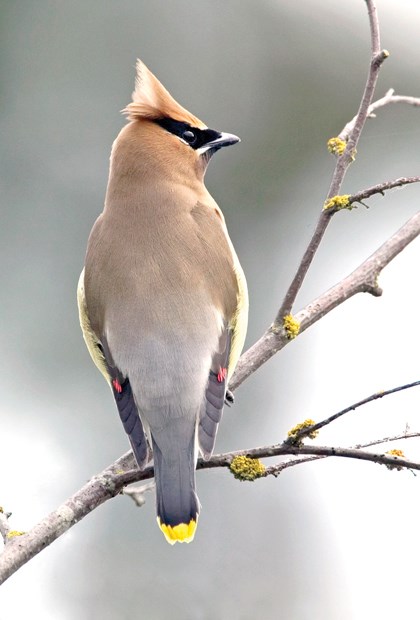Cool crisp mornings, cottonwood leaves turned golden and birds on the move, like skeins of geese winging their way south.
Summer birds (i.e. Neotropical migrants) have left us for warmer wintering areas in Central and Southern America. These include warblers, vireos, tanagers and flycatchers. One exception to the warblers is the hardy yellow-rumped, for it not only eats insects, but some fruit as well. The yellowrumped warbler consists of two distinctive types, the white-throated Myrtle and the yellow-throated Audubon's. Many of us remember when the two yellow-rumps were separate species. An endearing term for the yellow-rump is "butter butt."
Fall is also a great time of movement in raptors too, as some, like the osprey, depart for Central or South America, but others, like the roughlegged hawk, arrive locally to spend the winter.
Local red-tailed numbers are augmented by winter arrivals. It's always fun to look for plumage variation in red-tails. Some are darker, some lighter and some are in between (intermediate). Look for a large raptor with a white chest and dark belly band, but some birds won't show a red-tail. Red-tails are buteos that are built for soaring with a fan-shaped tail and broad wings. Like the song says, they make lazy circles in the sky. Sometimes they are joined by eagles, accipiters (like the Coopers hawk) and vultures on a good thermal (warm air column).
Shorebirds will have largely passed through our area on their way to wintering grounds in South America, but a few stay for the winter. These include greater yellowlegs, dunlin, sanderling and long-billed dowitchers. Killdeer and Wilson's snipe are resident waders.
The North Shore's surrounding waters provide habitat for wintering waterfowl like northern pintail, American wigeon, green-winged teal, and mallard - all dabbling ducks. Wintering divers include surf scoter, common goldeneye, bufflehead, ring-necked duck and scaup (lesser and greater). It's always exciting to watch for rarities like the Eurasian wigeon and common teal in flocks of regulars.
Be sure to check flocks of Canada geese for the tiny cackling goose, or perhaps a white-fronted goose. Snow geese gather on the Fraser River's delta by the thousands, coming from breeding grounds in Russia. Sometimes a few will land on the North Shore in spots like the Conservation Area at Maplewood Flats. The same thing may be said of swans, which are often seen (and heard) flying overhead. The commonly seen swan locally is the trumpeter. The tundra (formerly whistling) is much less common but should be watched for.
Waterfowl will be in their finery, having gone through a recent moult. Fall and winter are the best seasons to appreciate the beauty of our waterbirds and to get great pictures. The west pond at the Conservation Area is a fine place to begin your birding adventures.
Keep a watchful eye for the little birds, like sparrows, finches and waxwings. Lingering fruits on wild (Pacific) crabapple and hawthorn are a great attraction for birds like the cedar waxwing, American robin and purple finch.
At Maplewood, watch for sparrows, like the fox, song, golden-crowned, whitecrowned and maybe, if you are lucky, a white-throated sparrow. And then there are juncos and towhees, which are also sparrows.
Yes, early fall is a wonderful time of year - great birding and pumpkin pie! Keep safe.
Al Grass is a naturalist with Wild Bird Trust of British Columbia, which offers free walks at The Conservation Area at Maplewood Flats on the second Saturday of every month. The next walk will be held Saturday, Oct. 11 starting at 10 a.m. where participants will look for signs of fall and bird migration. Meet at WBT's Site Office, 2645 Dollarton Hwy. Walks go rain or shine.



